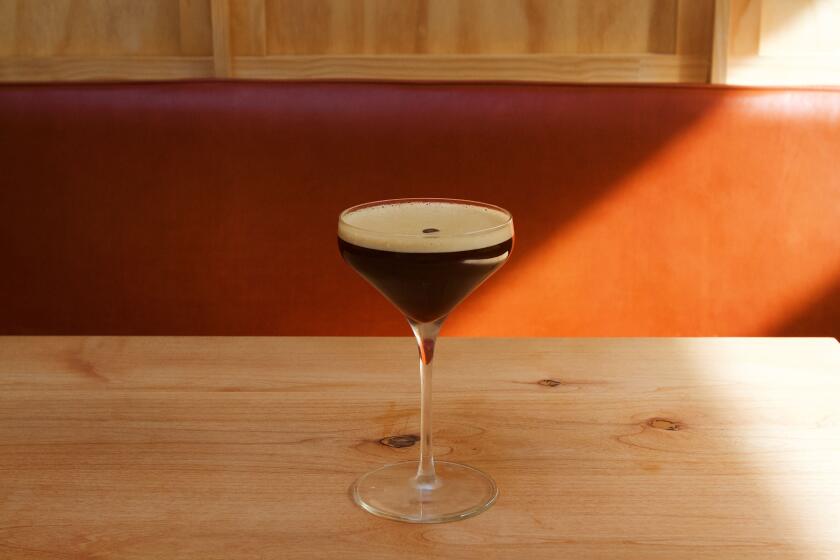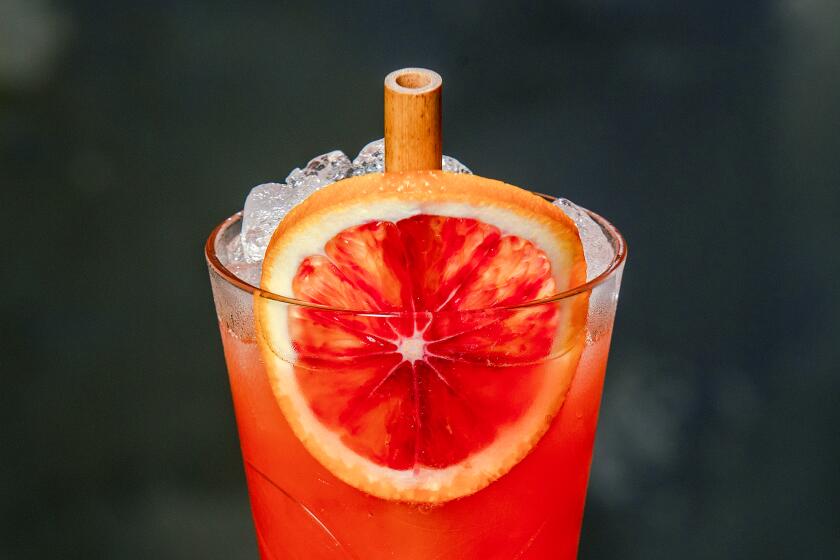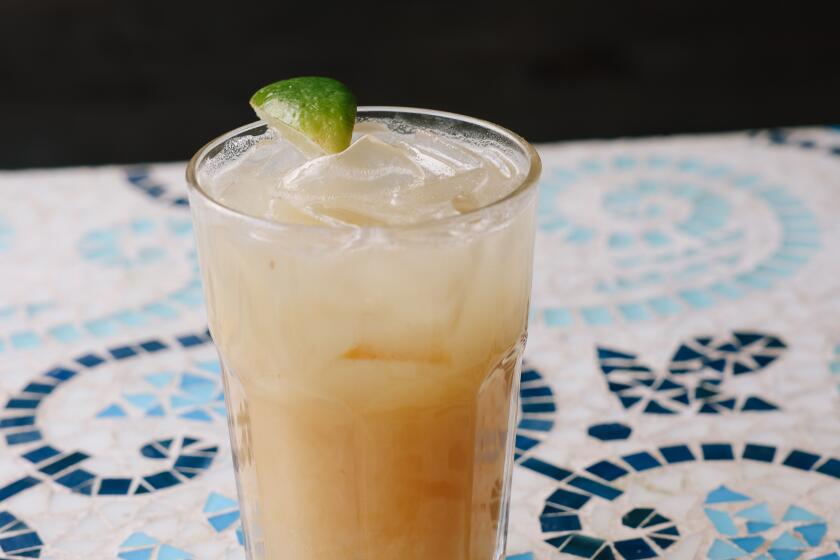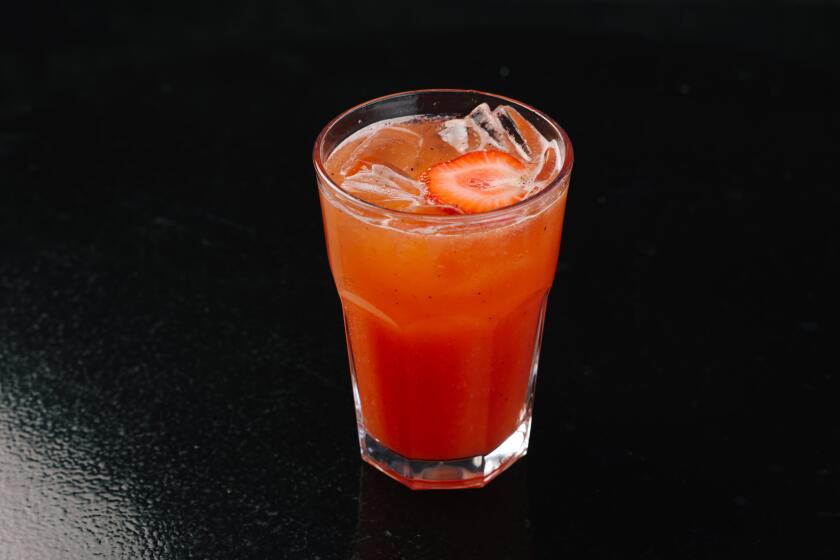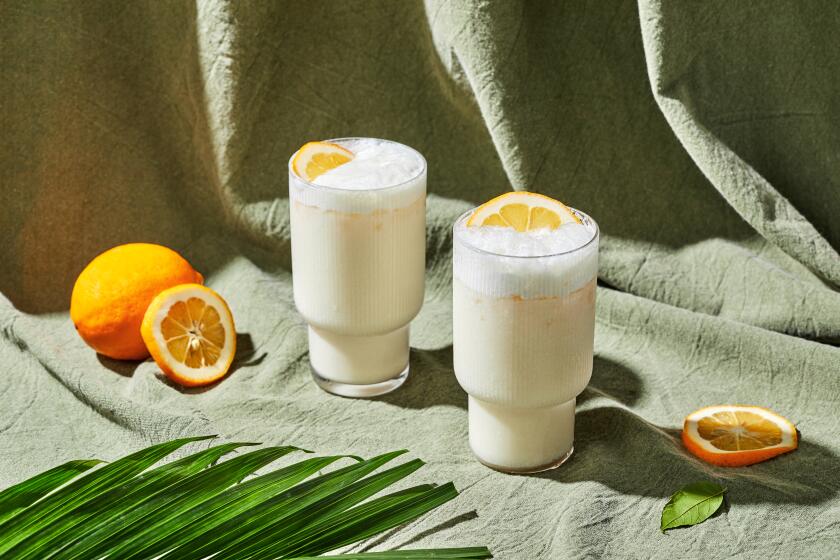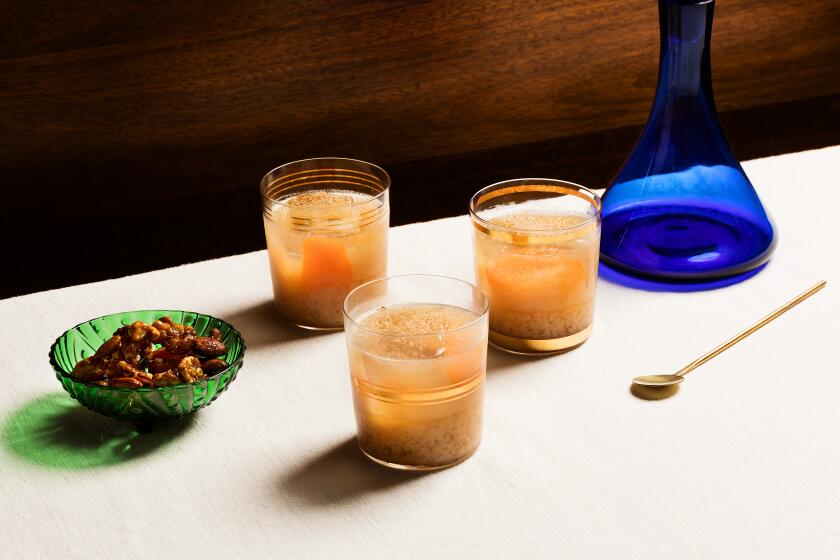Sora (sky) martini
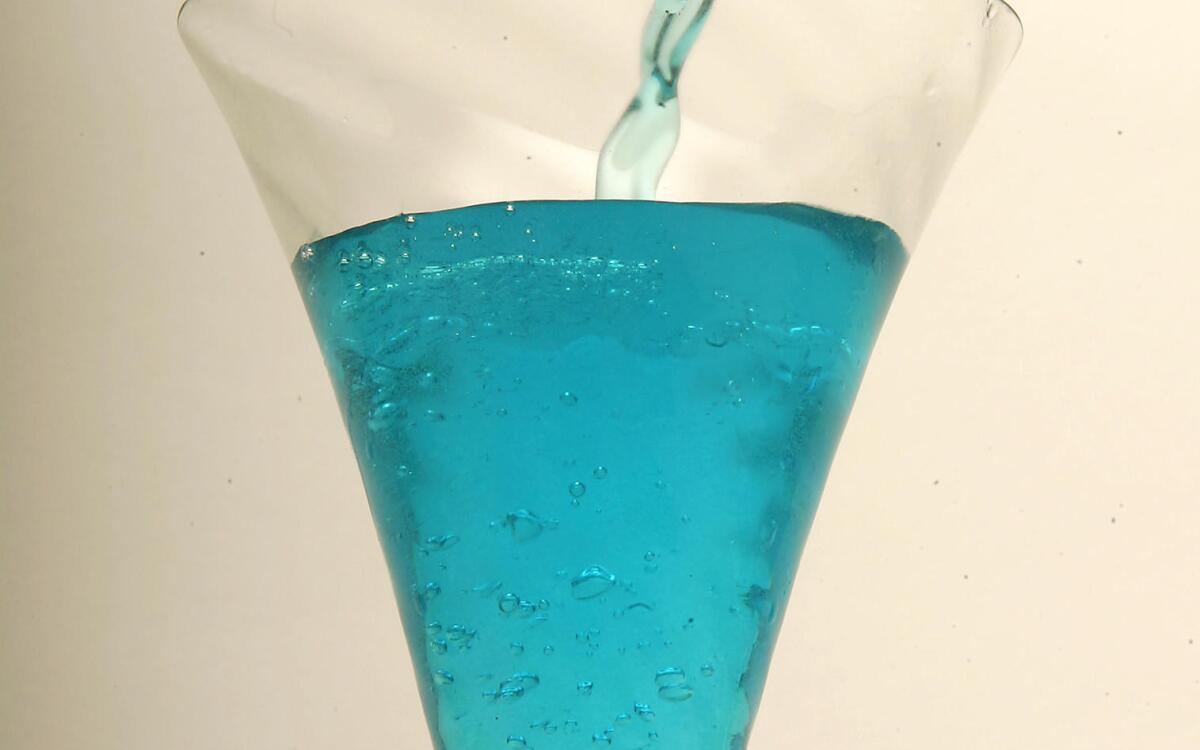
It’s always busy at Oki Doki, an izakaya, or Japanese pub-style restaurant, in a strip mall in Costa Mesa. Most nights, there are groups of students from nearby UC Irvine slouched outside the door, reading Japanese comic books or playing games on their cellphones, waiting for a table to open up.
It’s fun to sit on the sidelines and watch the action as a youthful army of tunic-dressed waitresses rushes around carrying aromatic small plates of sliced albacore with fried garlic chips, grilled smelt and steamed pork dumplings.
But watching the action I notice something else: Almost everyone is either drinking Japanese beer or chu-hai cocktails, drinks made with shochu, a clear distilled spirit similar to vodka but with about half the alcohol content. Not a single diner, as far as I can see, is having sake.
“Chu-hai is very, very popular now,” our waitress tells me, offering a drink list with 14 chu-hai concoctions. I ask her to pick out two of her favorites and she returns with a sea breeze chu-hai, made with white cranberry and grapefruit juices, for my wife, and an ume chu-hai, made with Japanese plums, for me.
What a revelation. The ume cocktail is just slightly sweet but more refreshing than a beer and less pungent than sake, my usual drink. It’s like a kir made with maybe a Pinot Gris or Sauvignon Blanc, but served on the rocks. No wonder practically everyone here has a chu-hai cocktail on the table.
Though shochu has surpassed sake as the beverage of choice in many izakaya restaurants in Japan, it’s only now starting to catch on in Southern California. Tom Cardenas, operations director for Katana in West Hollywood and Sushi Roku restaurants in Hollywood, Pasadena and Santa Monica, says, “Sake is still the big seller at our restaurants, but shochu is definitely sticking its shoulder in there. It’s becoming the beverage of choice for the hip, younger crowd.”
Cardenas, who frequently travels to Japan on business, says he first noticed the trend about three years ago when friends took him to an izakaya in Tokyo and he was the only one who ordered sake.
“It was all about shochu and chu-hai cocktails,” he says.
Despite its trendy status, shochu has been around a long time, probably originating in either China or Korea several hundred years ago. Just to make things really confusing, soju, the Korean name for the spirit, is also the term applied to Japanese shochu sold in the U.S., largely because the Korean version was imported here first.
Until recently, shochu had a bad rap as a cheap, nasty-tasting spirit. That’s largely the result of a historical hiccup. Distillers, who traditionally used rice or barley, were forced to switch to inedible sweet potatoes to make shochu when food rationing hit postwar Japan.
Like another well-known spirit, tequila, shochu became known as a working man’s drink. If you had the money, you drank sake; if not, you went for shochu.
But not anymore. Like tequila, shochu has developed a hip, upscale image, thanks in part to greatly refined brewing techniques and savvy Japanese marketing that has repositioned the spirit as refreshing, light and even healthful. (Some shochu producers claim that consumption can reduce the risk of heart attacks and strokes by producing enzymes that break down blood clots, but there’s no medical evidence to support this.)
“It’s definitely easier on the stomach and the head,” says Courtney Walker, a bartender at Blowfish whose signature cocktail, the X-Rated martini, is made with shochu and X-Rated liqueur, a vodka-spiked blend of blood oranges, mango and passion fruit.
Though the health benefits of shochu may be questionable, there is one undeniable fact: It’s lower in calories than an equal amount of vodka (around 35 calories in a 2-ounce pour compared with about 110 in an equal amount of vodka or 135 calories in 6 ounces of Chardonnay). Which might explain why it’s particularly popular with young women and anyone else concerned with the calories in alcohol.
Cardenas tells the story of an L.A. musician who often comes into Katana and always orders shochu. “I asked him why he likes it so much and he said it was for his health. He used to drink nothing but J&B, but when he switched to shochu, he said he lost 15 to 20 pounds without dieting.”
Can a West Hollywood Shochu Diet be far behind?
Most shochu is about 20% alcohol (wine typically runs 13% to 15%) and, by law, cannot be above 24%. Compared with most hard spirits that average about 40% alcohol, shochu is light enough, particularly when mixed, to be the perfect sipping cocktail for those hanging out during a long evening -- which is just what most people do at an izakaya.
Though the Japanese generally prefer shochu on the rocks or served with hot water garnished with salty ume plums, its similarity to vodka also makes it popular in cocktails, or chu-hais, mixed with fruit and vegetable juices.
In Japan, premixed chu-hai cocktails, sold in single-serving cans that include flavors such as grapefruit and cucumber, are available at such places as street vending machines and subway kiosks.
Oki Doki carries nine types of shochu or soju, some made with rice, others with barley, and one with sweet potatoes.
I sampled one of each, straight on the rocks with a twist of lemon, and discovered dramatic differences in taste. The rice shochu was the most delicate tasting with almost no aroma. The barley version was slightly sweet, had more body than the rice shochu, but was still very clean and crisp. The sweet potato soju, from Korea, had a much more pronounced sweetness. Just one sip, which coated my mouth with a heavy, petroleum-like film, made me sense that this version would cause a major hangover.
Because so many different shochus are being imported, it’s difficult to figure out which are the best, other than by tasting. But the bartenders and managers at an izakaya can point out bestsellers. Tori Kai, distilled from polished rice, is a favorite in Japan, as are Ginza No Suzume and Il Chiko Shochu, both made with barley. Han Soju, a popular Korean brand, is distilled from rice and barley.
After you’ve decided on a style of shochu, there are dozens of different ways to mix it. Kell Wimmer, sommelier at Geisha House, took a page out of the Japanese playbook to come up with a chu-hai made by muddling cucumber in the bottom of a cocktail glass, adding ice and topping with shochu. He says its low alcohol content makes it “more friendly than a martini or something like a cosmopolitan.”
“It’s a really good drink for people who want to go slow and not get drunk,” says Hiroshi Ishikawa, manager of SaSaYa in West Los Angeles, an izakaya that carries 20 varieties of shochu and serves up a number of different shochu-based cocktails such as the sora (sky) martini, made with blue Curacao and plum wine.
Bartenders at Sake House Miro, which has 16 chu-hai cocktails on the menu, prefer Korean soju in cocktails for its sweetness.
“The alcohol content is just slightly higher than wine but when you mix it in a cocktail, it’s pretty light and I think a lot of people like that,” says manager Alan Young. Sake House Miro’s most popular chu-hai cocktail, the aloha, is made with equal amounts of pineapple and cranberry juice mixed with Korean soju in a beer mug.
Personally, Katana’s Cardenas still prefers sake. “It has more depth,” he says. But he admits that shochu is more of a social drink. “It’s a particularly good choice when you’re eating izakaya-style Japanese food,” he says. “It’s lighter and doesn’t dull your appetite. Besides, it’s hip.”
Which might just be the final word on the subject.
In a cocktail shaker half filled with cracked ice, combine shochu, Curacao and plum wine. Shake vigorously and strain into a chilled martini glass.
Get our Cooking newsletter.
Your roundup of inspiring recipes and kitchen tricks.
You may occasionally receive promotional content from the Los Angeles Times.










